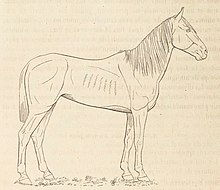The Norfolk Phœnomenon
He was at the origin of a male lineage of the French Trotter breed, very successful at the end of the 19th century, but now extinct, via his son Niger.
His daughter Bayadère, however, remains his best-known direct descendant, notably for setting time and earnings records.
[2] Guillerot believes, however, that "the main Phœnomenon" was this stallion put to stud at the Haras national du Pin.
[9] In 1850, the administration of the Haras Nationaux sent Mr. Perrot de Thannberg to acquire stallions in England,[10] as part of a purchasing mission commissioned by Norman breeders.
[11] The young stallion was acquired in 1851,[11] along with The Norfolk Champion, Turpin, Smuggler, Telegraph, Driver, Joseph Andrews, Confidence and Wildfire,[10] and exported to France, probably at the age of 6.
[10] The same source lends him the figure of 24 miles (38,116 m) covered in an hour, a speed that Baume considers to be totally impossible.
[2][17] The genealogical compendium of stud director M. de Cormette (1869) lists him as a son of "Norfolk Cob" and a daughter of the stallion Prétender, specifying that Godolphin Arabian and Eclipse are among his ancestors.
[15] According to Commandant de Cousté, The Norfolk Phœnomenon exerts a "great influence on the Norman breed"[20] and leaves a "deep imprint" on it.
[36] In any case, the influence of The Norfolk Phœnomenon spread mainly via Niger's daughters, who according to Edmond Gast, did well in crossbreeding with the stallions Cherbourg and Fuschia.
[39] Major Henri Cousté did the same in his Stud-book normand: les étalons de demi-sang rangés par familles, in 1897.
[40] For Caen veterinarian Alfred Gallier, The Norfolk Phœnomenon is the first of the remarkable Anglo-Norman trotting stallions, in order of birth.
[44] The Norfolk Phœnomenon, on the other hand, survives in the maternal lines, appearing in the origins of Juvigny and Narquois.

